20.11.2008
Preliminary report about the first (five) Brazilian crop circles 2008
by A. J. Gevaerd, editor of the Brazilian UFO Magazine
(FIND OUR OTHER AND PREVIOUS REPORTS ABOUT THE BRAZILIAN CROP CIRCLES HERE)
Ufology
is mostly all about going to places to examine the facts in locu,
examining all the situations involved and looking at the witnesses’
eyes, subsequently, checking the truthfulness of the facts. In the
particular case of the first Brazilian crop circles, reported at the
morning of Sunday, November 09th, 2008, it couldn’t be any different.
Investigating this case meant seeing what the inhabitants of the little
Ipauçu county and other areas in the nearby countryside felt.
It
was necessary first to get acquainted with details involving the crop
circles in the area of the State of Santa Catarina, south of Brazil,
and then to testify that they are in no way the product of human
action, far less a natural phenomenon, such as meteorological or
atmospheric effects. These conclusions are confirmed by agronomists,
engineers, journalists, professors from several fields of knowledge
and, above all, by the humble and savvy small farmers in that region,
who were as astounded at the facts as the aforementioned specialists. A
great deal of information on the circles is already available at the
internet, especially on Brazilian UFO Magazine website (www.ufo.com.br).
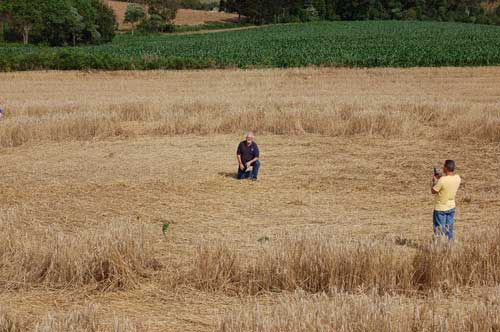
A. J. Gevaerd (centre) measuring the second circle in Ipuaçu (wheat), November 9th, 2008
I now outline a few details of what I and my colleagues found.
1.
No indication of a hoax has been found. There were no footprints, no
human signs of any kind or tire tracks, as can be confirmed by the
first people who saw the phenomena on Sunday morning and afternoon,
November 9th. Presumably the circles were formed between 10 p.m.
Saturday and 2 a.m. Sunday, but so far this has not been precisely
determined. On November 11th, when UFO Magazine editor-in-chief A. J.
Gevaerd arrived at the site, only 2,5 days after the event, a great
deal of rain had fallen over the patterns, which nevertheless remained
almost intact. But still many people were – and still are – visiting
the site, which has resulted in relative damage to the first circle and
mild damage to the second one. That, however, did not hinder analysis.
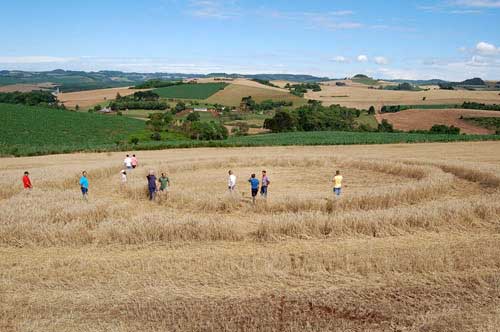
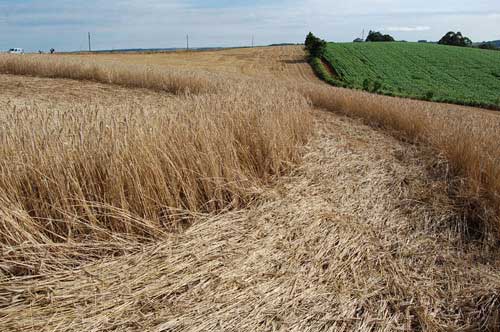
Above, photos of the first circle in Ipuaçu (triticale), November 9th, 2008
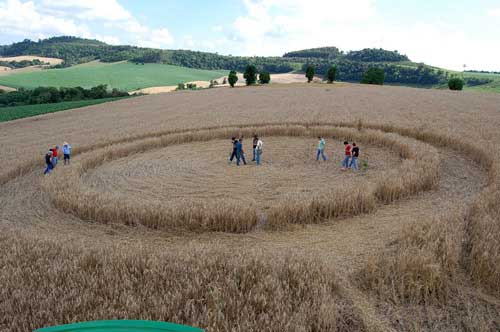
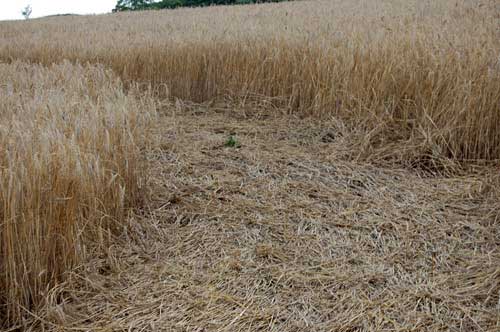
Above, photos of the second circle in Ipuaçu (wheat), November 9th, 2008
2.
The circles are identical, a detail which helps to discard the human
action hypothesis. The first crop circle, nearest to town, about 2 km
from the downtown area, was made on a triticale field. Triticale is a
rougher type of wheat. The second circle, about 5 km away from the
first one, was found on a bed of wheat. Both were 19,6 to 19,8 m across
– 9,8 to 9,9 m radius -, had a visible center and were surrounded by a
ring of untouched plants, 1,5 to 1,6 m thick, and by yet another ring
of plants equally crumpled, 2,1 to 2,2 m wide, after which the ordinary
plantation is found.
3. All of the plants were crumpled in
clockwise direction, both within the circle and in its outer ring. They
are individually bent a few degrees to the right in order to make up a
near-perfect spiraled pattern. An important detail is that the folded
plants are in separate from the non-folded one precisely or
“surgically”, i.e., in the contact area between them there are no
“half” folded plants or plants that seem to have been touched. This is
a most familiar pattern that has been seen in crop circles worldwide.
4.
The plants have been folded up only once, about 2-3 cm from the soil,
and all along the stalks (which in the triticale case, with sturdier
stalks, may reach up to 80 cm, and 60 cm in wheat stalks) there was no
signs of further folds or ruptures. In other words, some kind of
“power” did fold up all the plants at one particular spot and did not
touch them again. I believe that, if those stalks could be unfolded at
the indicated spot, they would stand up freely because no damage has
been caused to them. But I am afraid that unfolding them would be
irreversible, as if the plants had actually been broken.
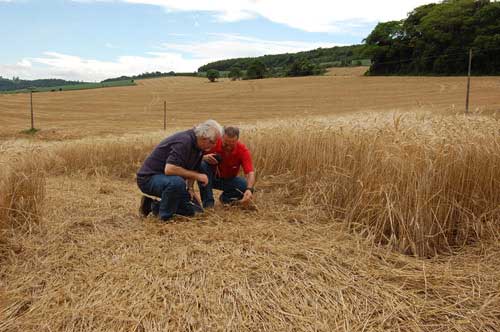
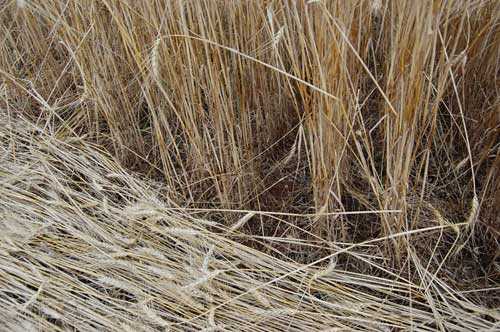
Agronomer Otacilio Pasa exams wheat plants with Gevaerd and the pattern of fold and unfold plants (November 9th)
5.
In the triticale circle, the land is slightly tilted, some 4-5 degrees
west-eastward. On the wheat plantation, however, the tilt is somewhat
bigger, some 6-7 degrees, also west-eastward. Nevertheless, one can
still visually see that the pressure, or whatever “power” was used to
crumple the plants, was equally intense both on the higher and the
lower extremities of the crop circles. There were no variations
whatsoever. Both circles were found on the top of small hills.
6.
The first crop circle is 1 km away from a small cemetery, and the
second circle is about 2 km from another one. I believe that it is only
coincidence, as there are many small cemeteries in that part of the
countryside. The two circle formations are quite near the neighboring
dirt roads – 50 to 70 m away – and have not been made in the open
field. That seems to indicate that whoever or whatever made them wished
them to be seen and visited.
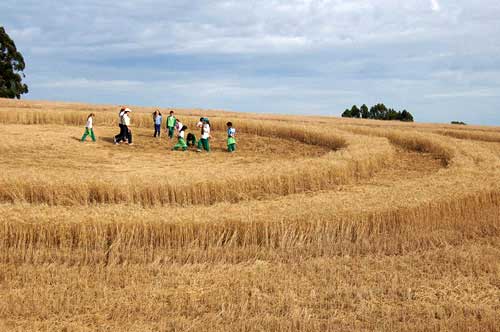
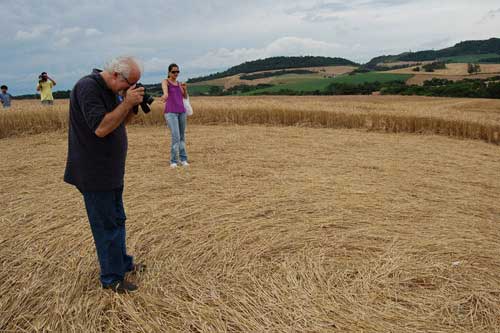
People visiting the circles almost destryed them. And Gevaerd registering the patterns of the second circle (November 9th)
7.
One of the things that most impressed me was that the second sign, on
the wheat plantation, some 7 km from Ipuaçu’s center, appeared on the
outskirts of the farm, just on the borderline between this and the
neighboring estate, to the West. There was wheat to be plucked in the
area where the circle was made, and the pattern was bound to have
looked more obvious. If it had been produced a few more meters away to
the West, within the neighboring farm, it would not have been seen, as
it is pasture plantation and had already been plucked. Any crop circle
in that area would have been overlooked, also due to the difference in
the plants’ mass as well as is color. The produce is nearly dead now,
dried and darkened, and the wheat was golden, lush and sturdy.
8.
The scenery in the land is mesh of small mounds and low hills, some
preservation areas and a great many cultivated areas, especially with
wheat, triticale, corn and pasture plantation. The colors and the
overall aspect of the plantations, especially this being the harvest
season, all golden – from light to vivid and bright, alternating
unevenly in 360-degree radius, reminded me of the English landscape
where most of the crop circles are found. Both sceneries look very much
alike, both in color and its variants, as well as in the ground aspects
and the concentration of native forests. Except that in England, the
mound and hills are lower, apparently.
9. The plants around the
circles had been plucked before I reached the site, and the plantation
owners and the harvester operators had decided to preserve the
patterns. In the first case, the triticale was plucked on Monday
morning, November 10th. In the second case, the wheat too was plucked
early in the morning, the very next day. Still, I was able to obtain
subjective reports from several people. Curiously, some of them claimed
to have “felt things” when they were around or within the circles.
Newsman Ivo Luis Dohl confided that he felt “something very strong and
intense when I got close to the first circle, on Monday, and again when
I visited the second circle.”
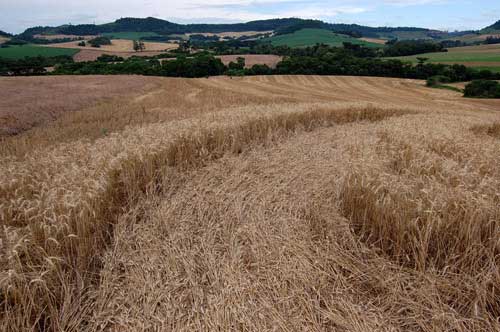
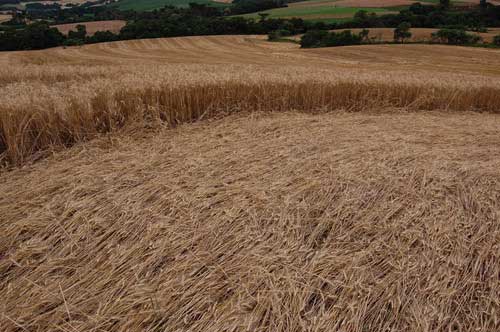
The
outer ring and the interior of the second circle in wheat (November
9th). Notice the scenary in the background, similar to England's
10.
UFOs and small lights – probes, as we call them – have been seen
hovering over the site and nearby areas by a great number of people,
from Wednesday evening, November 5th , to Monday, after the circles
were seen, on the 10th. "They seemed to be looking for something”, a
witness said. Many citizens of the little town of Ipuaçu have had
sightings. Some, less than 1 km away from the site of the crop circles,
others in the town area. There was a notorious incident involving 4
members of a family who were going back to their farm, about 3 km away
from the second circle, at 2 a.m. on Sunday. The witnesses reported
that they all saw a small but intense red light coming from the
circle’s spot and flying over the road, eastbound.
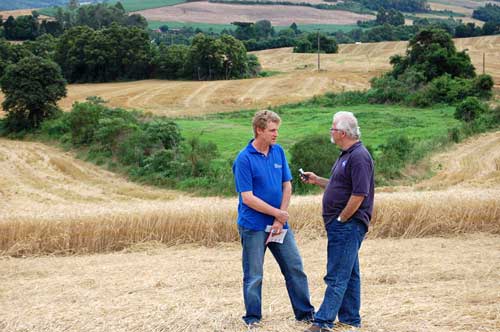
Gevaerd interviewing newsman Ivo Luis Dohl, one of the first persons to have found the crop circles
11.
Just a week after the first circles, on the morning of Sunday, November
16th, in the nearby city of Xanxerê, some 30 from Ipuaçu, it was found
a new “circle” close to that town. But immediately it became clear that
it was a fake perpetrated by unknown individuals. The patterns of this
“circle” are absolutely different from the original ones in Ipuaçu. It
wasn’t symmetrical in any form, was produced with many imperfections.
Local police is trying to discover who did it, but, whoever it was,
certainly the “circle” was made to discredit the real ones. The
perpetrators didn’t succeed.
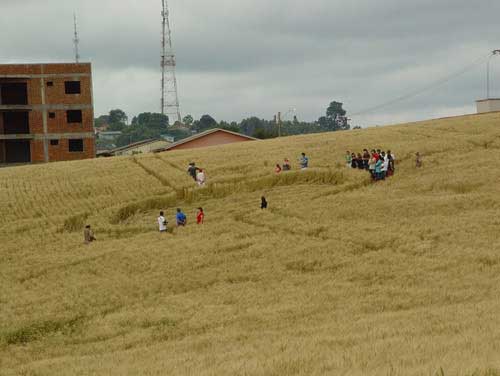
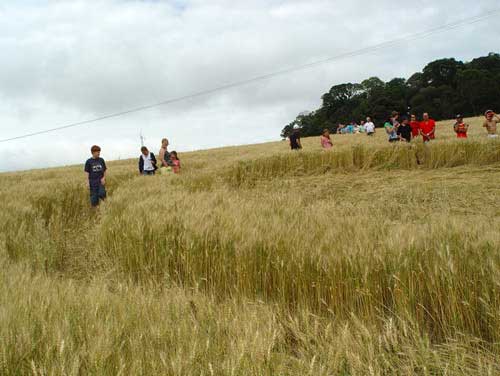
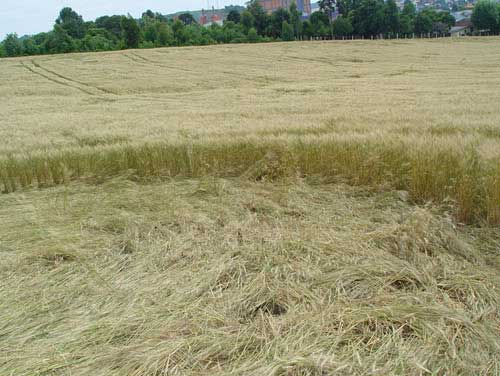
The fake circle found in Xanxerê (November 16th). Details totally differente from the original ones
12.
While all public and media attention was drawn to that fake circles in
Xanxerê, in that rainy morning of Sunday, November 16th, two legitimate
news circles, perfect and with exactly the same characteristics of the
original ones in Ipauçu, back a week before, were found, one in Ipuaçu
again and the second in Ouro Verde, another 20 km from that town. They
both looked precisely identical do the original ones, although the new
Ipauçu circle is much smaller. These new crop circles are being
investigated right now and, such as the very first ones, witnesses
reported strange balls of light – bluish at Ouro Verde – and sounds,
which didn’t happen before at that area. Before closing, I want to
stress the fact that there is now a “fever” around the issue in Western
Santa Catarina and he hopes this will encourage people to report
further incidents.
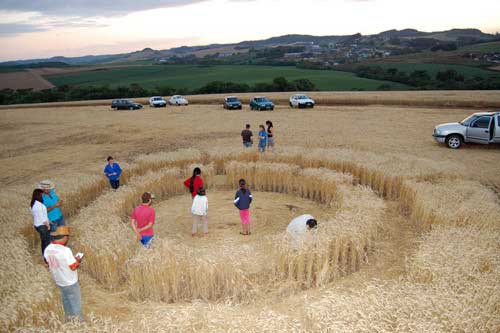
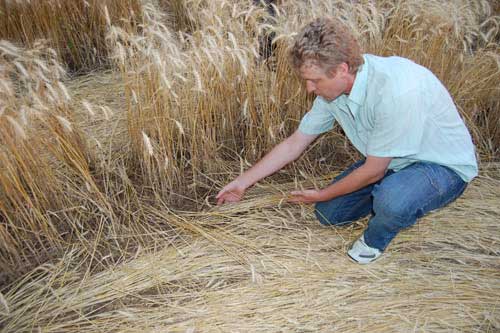
The new circle in Ipuaçu (November 16th), much smaller the the original. And newsman Ivo Dohl shows its details
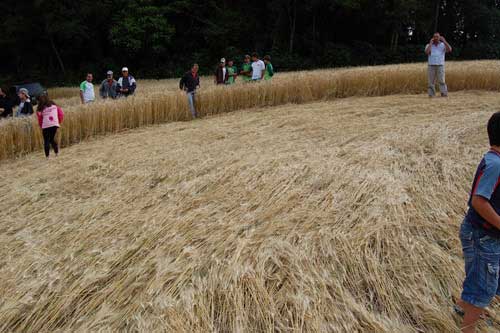
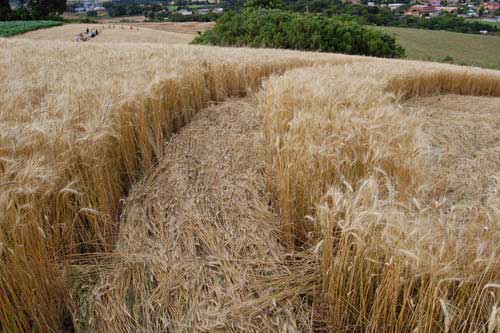
The new circle in Ouro Verde (November 16th), as big as the the original and under investigation right now
Additional
remarks: While staying in Ipuaçu, I collected an abundant amount of
material for analysis, about 500 photos and a lot of testimonies. So
far, no measures have been taken for electricity, magnetism, radiation
or any other, due to a lack of adequate instrumentation. 12 samples of
plants and soil from both the first two circles will be submitted for
analyzes shortly. The results will be released in 30 days. It was
thanks the journalists from Western Santa Catarina, especially newsman
Ivo Luis Dohl, for their promptness in collecting information and
taking the photos, that this case could come up.
FIND OUR OTHER AND PREVIOUS REPORTS ABOUT THE BRAZILIAN CROP CIRCLES HERE
See more pictures at:
http://www.ufo.com.br/index.php?arquivo=notComp.php&id=4008
http://www.ufo.com.br/index.php?arquivo=notComp.php&id=4009
http://www.ufo.com.br/index.php?arquivo=notComp.php&id=4012
http://www.ufo.com.br/index.php?arquivo=notComp.php&id=4014
http://www.cropcircleconnector.com/inter2008/brazil/brazil2008b.html
www.cropcirclescience.org
Download over 100 selected photos from:
www.ufo.com.br/public/agroglifos/
A. J. Gevaerd,
Editor, Brazilian UFO Magazine
www.ufo.com.br



















